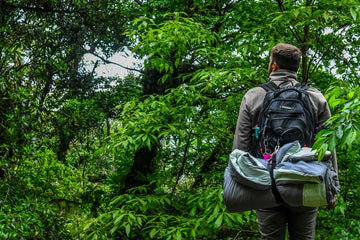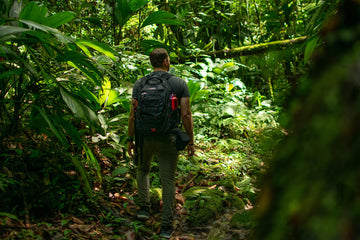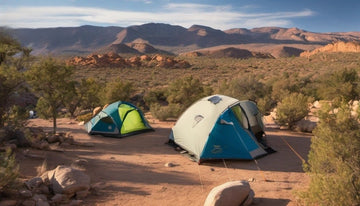
Camping is the enjoyment of purposely removing modern-day comforts for your vacation.
Camping trips can range from pushing your body and willpower to the edge and living with as few comforts as possible to achieve a deep connection with nature, or it can simply be forgoing the distractions that separate us from the outside and each other. Disconnecting from the digital and electronic world we find ourselves in for all our waking hours can be a rewarding experience. Whether solo hiking a mountain range or enjoying a long weekend at your local campground, your camping trip will be significantly less comfortable without the essentials.
Below, we have broken down our essential camping gear to create the ultimate packing list, from having the right bed to some secret and handy gear for creature comforts away from home.
Choosing the Right Shelter and Sleeping Gear
First and foremost, selecting the proper shelter and sleeping gear means that whatever mother nature throws at you, you'll have a warm place to lay your head at the end of the day.Tents for shelters are often one of the most expensive purchases for camping gear; however, without them, you can expect a significantly more rugged trip. When considering tents, consider that the "person rating," such as one-person, two-person, etc., includes only the average human body. If you plan on keeping more of your gear, such as your backpack, inside the tent opt for the next larger size. The basic rule of thumb is the smaller the tent, the easier it will be to keep it warm. Many tents have zippered vents, and rain flies to keep you dry or cool, depending on the weather. A strong zipper is an often overlooked feature of tents; having your tent zipper break when nature calls is an event best avoided by spending a few extra dollars.

Figure 1 Rainfly open and a view worth remembering
There are two main styles of sleeping pads. One is an inflatable sleeping pad; the other is solid foam-style.
Inflatable sleeping pads require the extra effort of inflation and can spring a leak, leaving you in an uncomfortable and often cold position. Inflatable pads can compress into very manageable sizes.
Solid foam pads are often lightweight but do occupy more space. Pads can be handy in various camping and hiking applications, such as giving an extra layer of padding when sitting down, resting, or glassing the opposite hill for wildlife.
Sleeping bags come in several styles, with the two most popular being the rectangle or mommy bag.
Rectangle bags are easy to use but are often reserved for warmer weather and lighter-duty camping.
The mummy bag completely encapsulates the camper and is often made of lighter-weight materials. It can also be purchased with a higher insulative rating for winter or cold-weather camping.
Clothing Essentials for Various Weather Conditions
You could fill an entire book or at least a catalog with your different options when it comes to clothing. Every camper's clothing needs will differ based on their activity and the conditions. However, we can provide a couple of reliable points to consider.First off, always dress in layers; this will allow you to put on an extra layer Should the temperature turn cooler or windier or remove layers to reduce the chance of excess sweating. These layers are essential when beginning a camping trip in cold weather where campers may rapidly warm with exercise. For warm or cold weather, man-made fibers such as polyester and nylon provide a great lightweight option and compress easily. Unlike cotton, which will continue to stay damp with sweat or precipitation, these materials are also considered quick dry. One word of caution is that synthetic materials will melt if exposed to high temperatures. Examples of this you may encounter while camping are campfires or camp stoves. Not only will melted fabrics lose their insulative value, but they can also injure the camper. As such, it is important to remember to keep those fabrics away from the fire. Organic materials like wool or fireproof materials like Nomex are our recommendations for working directly with the campfire.
Second, always have a waterproof layer. A set of raingear or a hardshell jacket can easily be packed away in fair weather and will be worth the time it takes should the rain start. Being cold is uncomfortable, but being cold and wet can be dangerous. Waterproof clothing doesn’t stay waterproof forever, each manufacturer will have different care instructions for restoring the waterproofing of a piece of clothing. Most often re-waterproofing clothing involves spraying the article with a compound such as Durable Water Repellent and tossing it in the dryer. Depending on the amount of use the clothing gets this can range from a once a year to once a decade step.

Figure 2 A hardshell jacket can easily be packed away
Lastly, avoid cotton socks at all costs for camping. They trap moisture, and warm conditions increase the risk of blisters. Cold weather does not insulate the feet enough. Merino wool or synthetic compounds are a much better option. Pack an extra pair to keep your feet dry and warm.

Figure 3 Synthetic socks do come in fun colors too
Cooking and Food Supplies: Must-Haves for Campsite Meals
Depending on the duration and distance you are camping, the types of cooking supplies and foods you bring may differ. For example, when car camping, having a cooler to keep food from spoiling will significantly increase the options available. Items like fresh eggs and refrigerated meats can make breakfast, lunch, and dinner a cinch. To cut down on prep time and increase the efficiency of the coolers, freezing as many of the meals and ingredients ahead of time as possible allows these foods to stay cold and also other foods cold in the process. Hotdogs or steaks frozen before camping will act as an ice pack, keeping food cold and preventing spoilage without worrying about rising water levels from melting ice.Camping without a cooler requires all the food items to be shelf-stable or unrefrigerated. Instant noodles, MREs, and oatmeal are all top choices when backpacking. Two must-have camp meal times are a cast-iron skillet and aluminum foil. A cast-iron skillet can be set on a grill or directly on a flame and can make anything from pancakes to fried chicken. Aluminum foil only allows campers to steam foods inside foil pouches, but can also be used as an abrasive cleaner to remove stock on grime on grills. For utensils, a pocket knife can do most of the prep work, including whittling chopsticks out of twigs; a spork is still the champion of camping utility. Plus, it takes a lot of work to eat oatmeal with chopsticks.

Figure 4 Make anything from pancakes to fried chicken
Essential Tools and Accessories for Outdoor Comfort and Safety
Camp safety and comfort go hand-in-hand with any outdoor experience. After the sun goes down, lights are needed. A headlamp is ideal for most camping chores as it usually cannot be dropped, and the beam focuses in the direction that you are heading. The headlamp significantly lowers the risk of tripping over rocks, roots, and steaks. A lantern allows light over a larger area; these can sit on the table or be suspended from a tentpole, giving campers light to eat dinner, get dressed, or read after sunset. Glowsticks or reflective flagging are two lightweight items that work well for marking trip hazards and marking a trail to and from the campsite. Regardless of size, a shovel should be on your camping gear list. From digging a trench around your tent to digging a cathole when dispersed camping, the ability to move dirt will make your trip much more comfortable. A rescue whistle should be standard on every camper's day pack for additional camping safety. Second use, or perhaps the reason for multiple flashlights, is the strobe ability of a flashlight to help locate a lost camper, EDC or keychain lights are small, and inexpensive enough that they can be given to every member of the camp.Personal Items and Hygiene Essentials for Camping Trips
"Roughing it" while camping can include going without a daily shower, but that doesn't mean we are forgoing all of our hygiene routines. A toothbrush and toothpaste should definitely be brought along, as should any medications that you take daily. Those medicines can be stored in your first aid kit. Most first-aid kits are waterproof and feature compartments for additional medicine and tools.Protecting your skin while camping is important regardless of the season. Sunscreen should be worn all year on exposed skin. The sun's rays reflected off the snow have made many hikers look like raccoons; it's as uncomfortable as it is embarrassing. Bug spray and repellent will be worth their weight in gold during the summer months when mosquitos and flies are at their most prolific. Don't forget to treat your shoes and legs to prevent ticks from latching on while walking.

Figure 5 A tick looking for a ride
Miscellaneous Items: Often Overlooked but Handy for Camping Comfort
As always, a few handy camping items never fit neatly in the gear checklist. Most of these items are on the list because they pull double duty fixing or improving all kinds of needs around the campsite. One of these items is Paracord. Paracord or 550 cord is available anywhere in every color imaginable. I have used it to secure a tent during a windy day, create a pull tab on a broken zipper, and hang my gear in a tree to avoid scavengers. Selecting brighter colored cords can also help with great flagging in the snow or low light conditions.A pocket hammock can be an excellent addition to the campsite when camping in areas with trees. From sleeping under the stars to keeping gear off the wet ground, the lightweight hammock will be of plenty of use in a campsite.
A portable charger or battery bank is handy, especially when camping for multiple days. Being able to charge your flashlights, GPS, and cellphone with one unit is a reassurance that will allow you to stay out longer.
Camping is rewarding. There are certainly challenges that come with it, but these challenges are what make camping so exciting. Planning and having the right gear, from tents and clothing to flashlights and cookware, allow each of us to relish in the experience of planning and enjoying the time spent outside. Take this list and begin your camping checklist; you'll soon find yourself outside and ready to take on whatever the campsite can throw at you.
Related Articles



